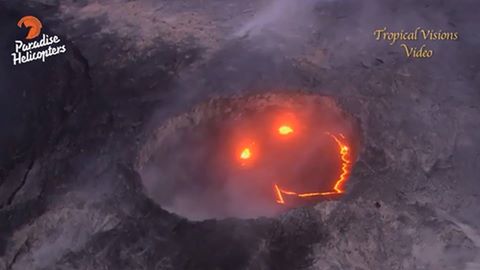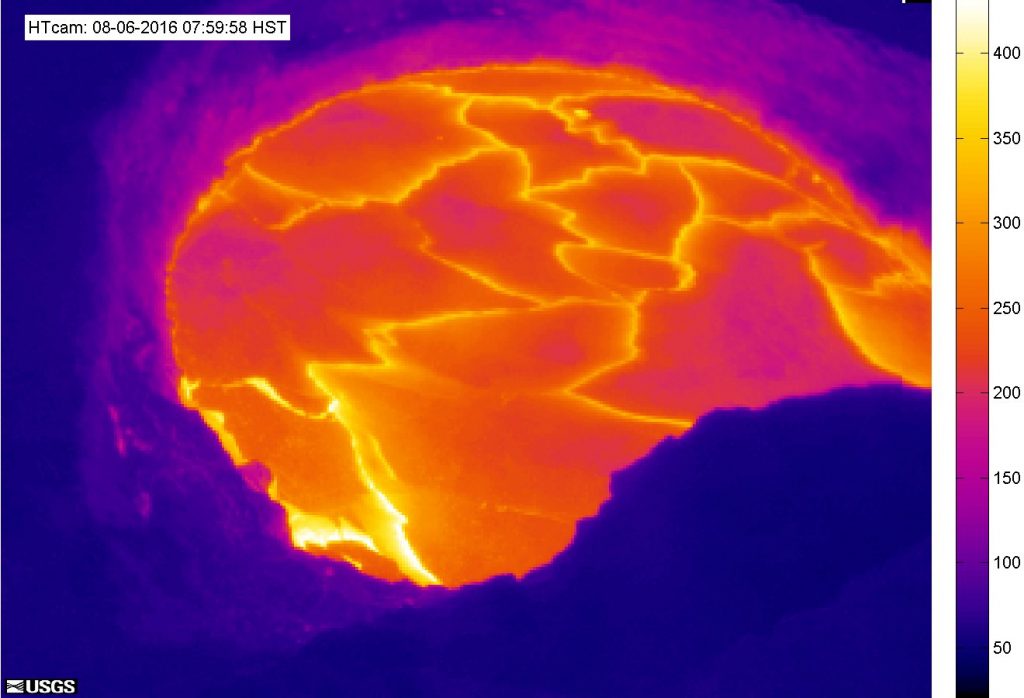A Smile From Pele as Lava Continues Flow Into Ocean
Eruptions continue at Kīlauea Volcano’s summit and East Rift Zone, the US Geological Survey’s Hawaii Volcano observatory reported on Friday, Aug. 5, 2016, at 8:58 a.m.
The 61G lava flow, extending southeast of Puʻu ʻŌʻō on Kīlauea’s south flank continues to flow into the ocean at Kamokuna, within the boundary of Hawaii Volcanoes National Park, and has scattered breakouts predominantly on the coastal plain. This new flow is now about 6.5 miles long.
The flow poses no threat to nearby communities, but visitors are advised to use caution.

Kalapana fly-over, Thursday, Aug. 4, 6 a.m. A view looking west at the 61G’s ocean entry. Rising gases demark the path of the lava from Pu‘u ‘O‘o (the little bump on the horizon), and down Pulama Pali, while the delta of new land continues to increase in size, and now extending approximately 40-50 yards from the base of the sea cliff. Paradise Helicopters photo.
The length of coast comprising the active entry has ranged between 150 m (492 feet) and 240 m (787 feet) in the past week and the entire area presents a significant hazard to visitors.
Lava Delta Forming: Paradise Helicopters reported that lava has begun to build a delta at the Kamokuna entry point on Thursday, Aug. 4.

Photo comparison of the emergency access road from July 25, the day the lava first crossed (left), and today Aug. 5 (right). The flow is now approximately 200 m (650 feet) wide on the road and has inflated to a few meters tall (HVO geologist for scale). USGS/HVO photo.
Fluid pahoehoe has repeatedly covered the newly completed access road and is now about a quarter-mile wide.
Lava rolled over Pulama Pali a month ago, mostly between Hawaii Volcanoes National Park and the abandoned Royal Gardens subdivision.
Only a handful of visitors made their way on foot this morning, Paradise reported, but three tour boats were on-hand at sunrise to take in the amazing spectacle of hot liquid rock interacting with the Pacific Ocean.
A large crack above the lava delta demonstrates the instability of the area, which could collapse into the sea at any time.
At their own risk, many gawkers stand at the edge of the cliffs to get a glimpse, Paradise reported.
“We visited the vent today as well and once again were able to access the steamy lava lake within the vent to the west,” Paradise reported. “As usual, a great deal of lava is moving quickly through a skylight on the northeast corner, feeding the ocean entry downslope.

This Pu’u O’o lava emoji was captured on July 28 by Paradise Helicopters and Tropical Visions Video.
Caution to Visitors: The USGS has issued a strong caution to visitors viewing the new ocean entry for Flow 61G, there are additional significant hazards besides walking on uneven surfaces and around unstable, extremely steep sea cliffs.
Venturing too close to an ocean entry exposes you to flying debris created by the explosive interaction between lava and water.
Also, the new land created is unstable because it is built on unconsolidated lava fragments and sand. This loose material can easily be eroded away by surf causing the new land to become unsupported and slide into the sea.
Finally, the interaction of lava with the ocean creates an acidic plume laden with fine volcanic particles that can irritate the skin, eyes and lungs.
Summit Observations: The lava lake at Halemaʻumaʻu Crater continues to be active with a current height of 40 m (131 feet) below the overlook crater rim.

Live Panorama of Halemaʻumaʻu Overlook Vent Thermal from Halemaʻumaʻu Overlook [HTcam]
Last Updated Aug. 6. USGS/HVO webcam.
Seismicity rates continue to be normal, with tremor fluctuations associated with lava lake spattering. The average daily summit sulfur dioxide emission rate ranged from 4,000 to 6,000 metric tons per day over the past week.
Puʻu ʻŌʻō Observations: Webcam images over the past 24 hours show persistent glow at long-term sources within the crater, indicating no significant changes. Seismicity and tilt records also showed no significant changes in the past day. The sulfur dioxide emission rate from all East Rift Zone vents was about 300 metric tons/day when measured on Aug. 3.














